Community Engagement: Building Strengths and Capabilities Learning in the Community Report
VerifiedAdded on 2023/06/11
|9
|2453
|177
AI Summary
This report discusses the community engagement activities undertaken by Wesley Vickery Sylvania, a residential aged care facility in Australia. It covers the community served, the disadvantage observed, and the impact on the student's values and attitudes. Suggestions for improving community engagement are also provided.
Contribute Materials
Your contribution can guide someone’s learning journey. Share your
documents today.

1
Secure Best Marks with AI Grader
Need help grading? Try our AI Grader for instant feedback on your assignments.
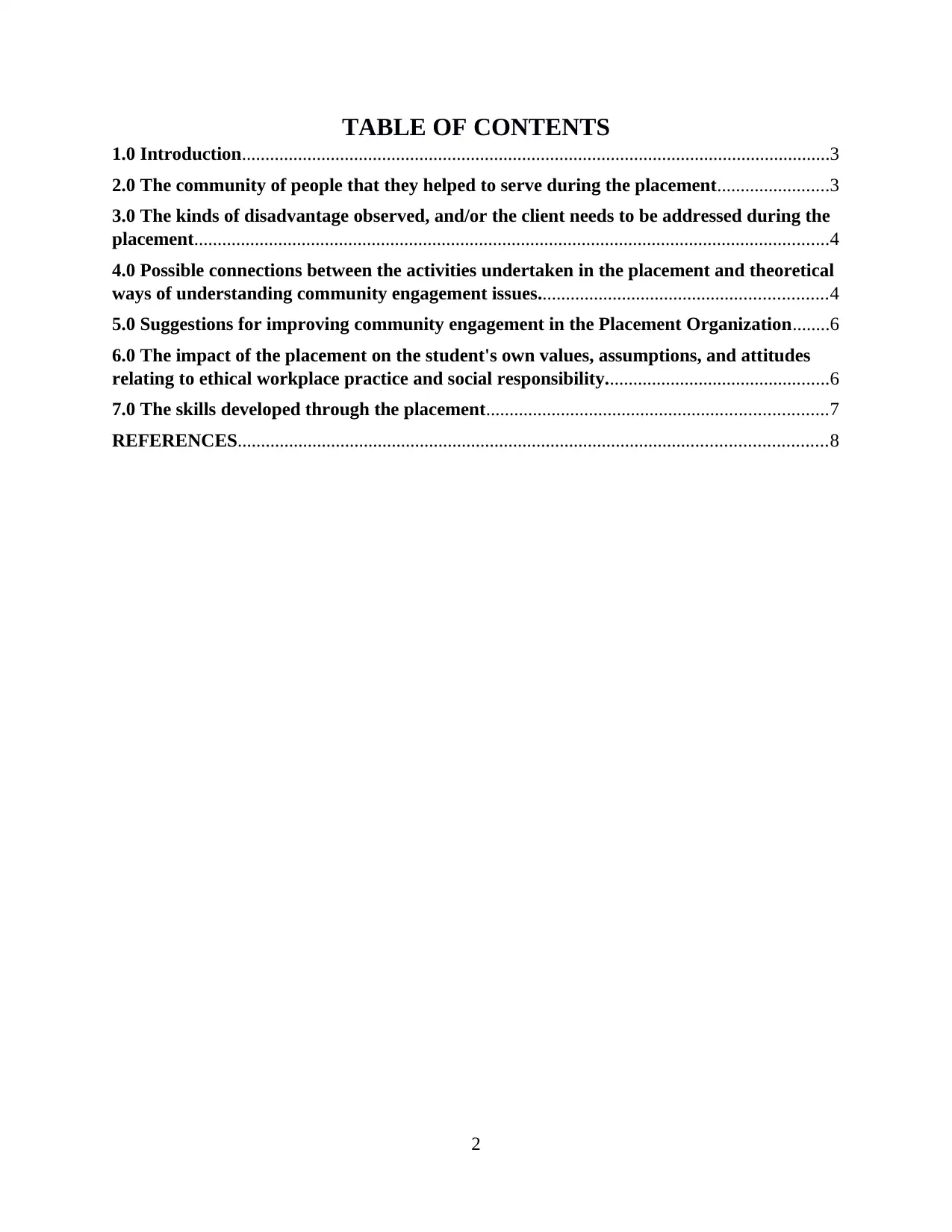
TABLE OF CONTENTS
1.0 Introduction..............................................................................................................................3
2.0 The community of people that they helped to serve during the placement........................3
3.0 The kinds of disadvantage observed, and/or the client needs to be addressed during the
placement........................................................................................................................................4
4.0 Possible connections between the activities undertaken in the placement and theoretical
ways of understanding community engagement issues..............................................................4
5.0 Suggestions for improving community engagement in the Placement Organization........6
6.0 The impact of the placement on the student's own values, assumptions, and attitudes
relating to ethical workplace practice and social responsibility................................................6
7.0 The skills developed through the placement.........................................................................7
REFERENCES..............................................................................................................................8
2
1.0 Introduction..............................................................................................................................3
2.0 The community of people that they helped to serve during the placement........................3
3.0 The kinds of disadvantage observed, and/or the client needs to be addressed during the
placement........................................................................................................................................4
4.0 Possible connections between the activities undertaken in the placement and theoretical
ways of understanding community engagement issues..............................................................4
5.0 Suggestions for improving community engagement in the Placement Organization........6
6.0 The impact of the placement on the student's own values, assumptions, and attitudes
relating to ethical workplace practice and social responsibility................................................6
7.0 The skills developed through the placement.........................................................................7
REFERENCES..............................................................................................................................8
2
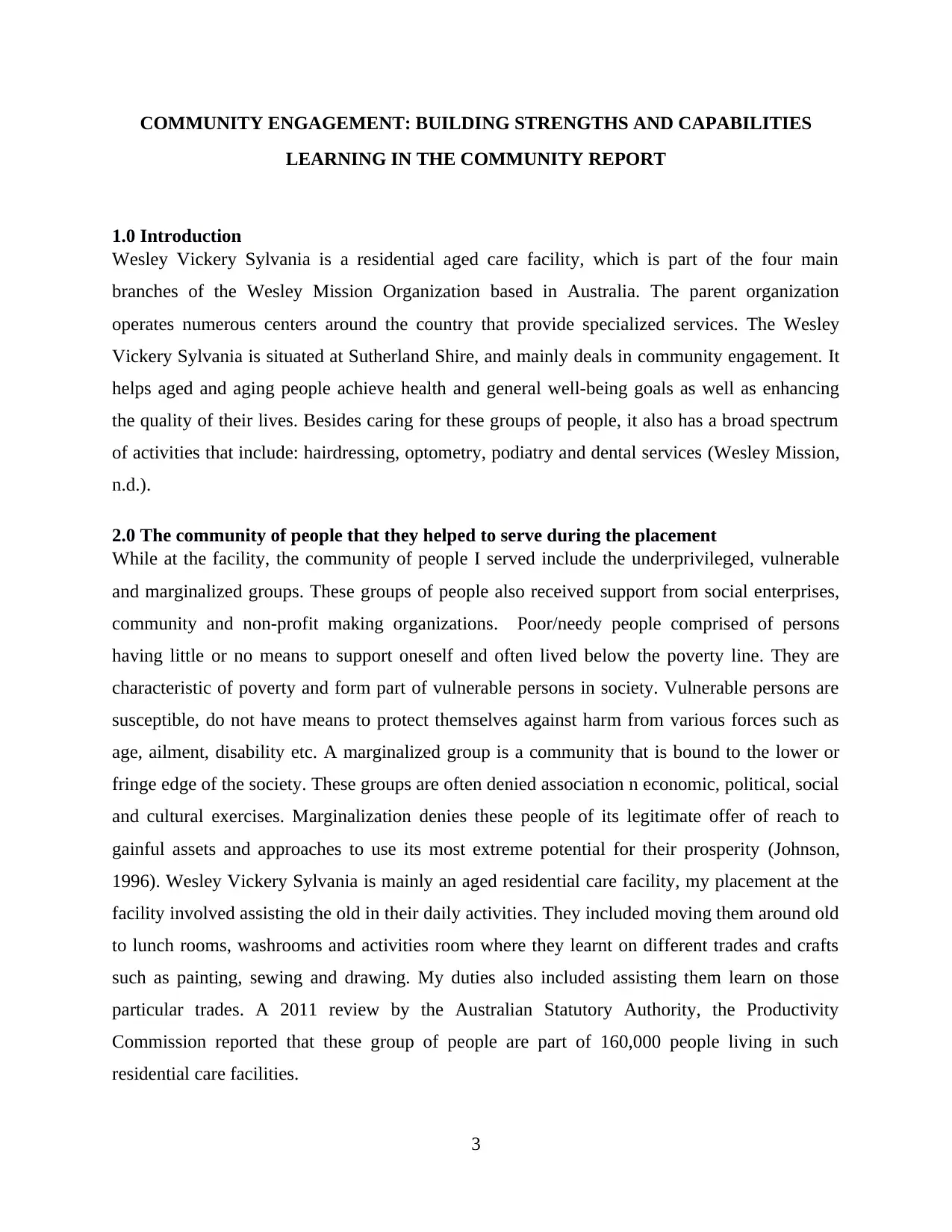
COMMUNITY ENGAGEMENT: BUILDING STRENGTHS AND CAPABILITIES
LEARNING IN THE COMMUNITY REPORT
1.0 Introduction
Wesley Vickery Sylvania is a residential aged care facility, which is part of the four main
branches of the Wesley Mission Organization based in Australia. The parent organization
operates numerous centers around the country that provide specialized services. The Wesley
Vickery Sylvania is situated at Sutherland Shire, and mainly deals in community engagement. It
helps aged and aging people achieve health and general well-being goals as well as enhancing
the quality of their lives. Besides caring for these groups of people, it also has a broad spectrum
of activities that include: hairdressing, optometry, podiatry and dental services (Wesley Mission,
n.d.).
2.0 The community of people that they helped to serve during the placement
While at the facility, the community of people I served include the underprivileged, vulnerable
and marginalized groups. These groups of people also received support from social enterprises,
community and non-profit making organizations. Poor/needy people comprised of persons
having little or no means to support oneself and often lived below the poverty line. They are
characteristic of poverty and form part of vulnerable persons in society. Vulnerable persons are
susceptible, do not have means to protect themselves against harm from various forces such as
age, ailment, disability etc. A marginalized group is a community that is bound to the lower or
fringe edge of the society. These groups are often denied association n economic, political, social
and cultural exercises. Marginalization denies these people of its legitimate offer of reach to
gainful assets and approaches to use its most extreme potential for their prosperity (Johnson,
1996). Wesley Vickery Sylvania is mainly an aged residential care facility, my placement at the
facility involved assisting the old in their daily activities. They included moving them around old
to lunch rooms, washrooms and activities room where they learnt on different trades and crafts
such as painting, sewing and drawing. My duties also included assisting them learn on those
particular trades. A 2011 review by the Australian Statutory Authority, the Productivity
Commission reported that these group of people are part of 160,000 people living in such
residential care facilities.
3
LEARNING IN THE COMMUNITY REPORT
1.0 Introduction
Wesley Vickery Sylvania is a residential aged care facility, which is part of the four main
branches of the Wesley Mission Organization based in Australia. The parent organization
operates numerous centers around the country that provide specialized services. The Wesley
Vickery Sylvania is situated at Sutherland Shire, and mainly deals in community engagement. It
helps aged and aging people achieve health and general well-being goals as well as enhancing
the quality of their lives. Besides caring for these groups of people, it also has a broad spectrum
of activities that include: hairdressing, optometry, podiatry and dental services (Wesley Mission,
n.d.).
2.0 The community of people that they helped to serve during the placement
While at the facility, the community of people I served include the underprivileged, vulnerable
and marginalized groups. These groups of people also received support from social enterprises,
community and non-profit making organizations. Poor/needy people comprised of persons
having little or no means to support oneself and often lived below the poverty line. They are
characteristic of poverty and form part of vulnerable persons in society. Vulnerable persons are
susceptible, do not have means to protect themselves against harm from various forces such as
age, ailment, disability etc. A marginalized group is a community that is bound to the lower or
fringe edge of the society. These groups are often denied association n economic, political, social
and cultural exercises. Marginalization denies these people of its legitimate offer of reach to
gainful assets and approaches to use its most extreme potential for their prosperity (Johnson,
1996). Wesley Vickery Sylvania is mainly an aged residential care facility, my placement at the
facility involved assisting the old in their daily activities. They included moving them around old
to lunch rooms, washrooms and activities room where they learnt on different trades and crafts
such as painting, sewing and drawing. My duties also included assisting them learn on those
particular trades. A 2011 review by the Australian Statutory Authority, the Productivity
Commission reported that these group of people are part of 160,000 people living in such
residential care facilities.
3
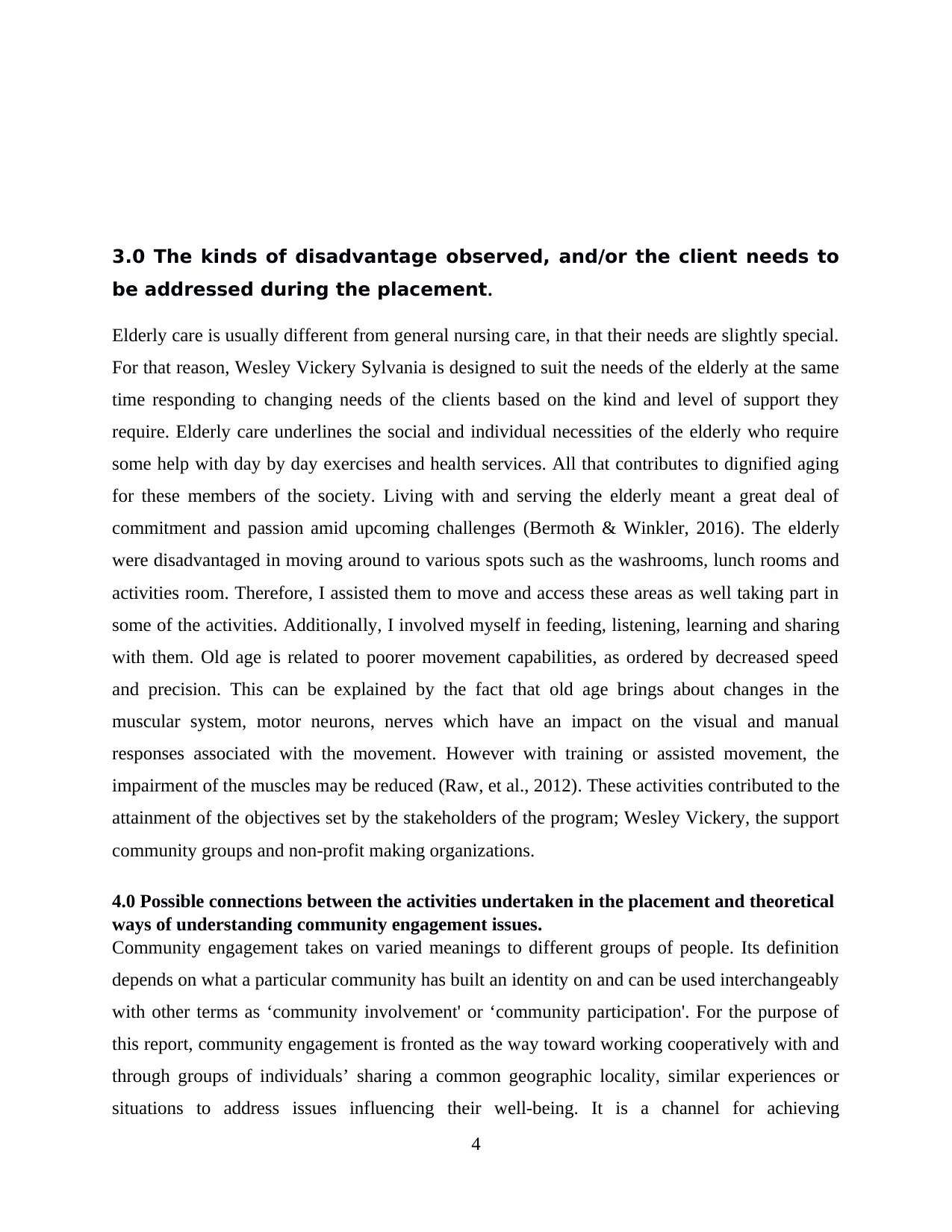
3.0 The kinds of disadvantage observed, and/or the client needs to
be addressed during the placement.
Elderly care is usually different from general nursing care, in that their needs are slightly special.
For that reason, Wesley Vickery Sylvania is designed to suit the needs of the elderly at the same
time responding to changing needs of the clients based on the kind and level of support they
require. Elderly care underlines the social and individual necessities of the elderly who require
some help with day by day exercises and health services. All that contributes to dignified aging
for these members of the society. Living with and serving the elderly meant a great deal of
commitment and passion amid upcoming challenges (Bermoth & Winkler, 2016). The elderly
were disadvantaged in moving around to various spots such as the washrooms, lunch rooms and
activities room. Therefore, I assisted them to move and access these areas as well taking part in
some of the activities. Additionally, I involved myself in feeding, listening, learning and sharing
with them. Old age is related to poorer movement capabilities, as ordered by decreased speed
and precision. This can be explained by the fact that old age brings about changes in the
muscular system, motor neurons, nerves which have an impact on the visual and manual
responses associated with the movement. However with training or assisted movement, the
impairment of the muscles may be reduced (Raw, et al., 2012). These activities contributed to the
attainment of the objectives set by the stakeholders of the program; Wesley Vickery, the support
community groups and non-profit making organizations.
4.0 Possible connections between the activities undertaken in the placement and theoretical
ways of understanding community engagement issues.
Community engagement takes on varied meanings to different groups of people. Its definition
depends on what a particular community has built an identity on and can be used interchangeably
with other terms as ‘community involvement' or ‘community participation'. For the purpose of
this report, community engagement is fronted as the way toward working cooperatively with and
through groups of individuals’ sharing a common geographic locality, similar experiences or
situations to address issues influencing their well-being. It is a channel for achieving
4
be addressed during the placement.
Elderly care is usually different from general nursing care, in that their needs are slightly special.
For that reason, Wesley Vickery Sylvania is designed to suit the needs of the elderly at the same
time responding to changing needs of the clients based on the kind and level of support they
require. Elderly care underlines the social and individual necessities of the elderly who require
some help with day by day exercises and health services. All that contributes to dignified aging
for these members of the society. Living with and serving the elderly meant a great deal of
commitment and passion amid upcoming challenges (Bermoth & Winkler, 2016). The elderly
were disadvantaged in moving around to various spots such as the washrooms, lunch rooms and
activities room. Therefore, I assisted them to move and access these areas as well taking part in
some of the activities. Additionally, I involved myself in feeding, listening, learning and sharing
with them. Old age is related to poorer movement capabilities, as ordered by decreased speed
and precision. This can be explained by the fact that old age brings about changes in the
muscular system, motor neurons, nerves which have an impact on the visual and manual
responses associated with the movement. However with training or assisted movement, the
impairment of the muscles may be reduced (Raw, et al., 2012). These activities contributed to the
attainment of the objectives set by the stakeholders of the program; Wesley Vickery, the support
community groups and non-profit making organizations.
4.0 Possible connections between the activities undertaken in the placement and theoretical
ways of understanding community engagement issues.
Community engagement takes on varied meanings to different groups of people. Its definition
depends on what a particular community has built an identity on and can be used interchangeably
with other terms as ‘community involvement' or ‘community participation'. For the purpose of
this report, community engagement is fronted as the way toward working cooperatively with and
through groups of individuals’ sharing a common geographic locality, similar experiences or
situations to address issues influencing their well-being. It is a channel for achieving
4
Secure Best Marks with AI Grader
Need help grading? Try our AI Grader for instant feedback on your assignments.
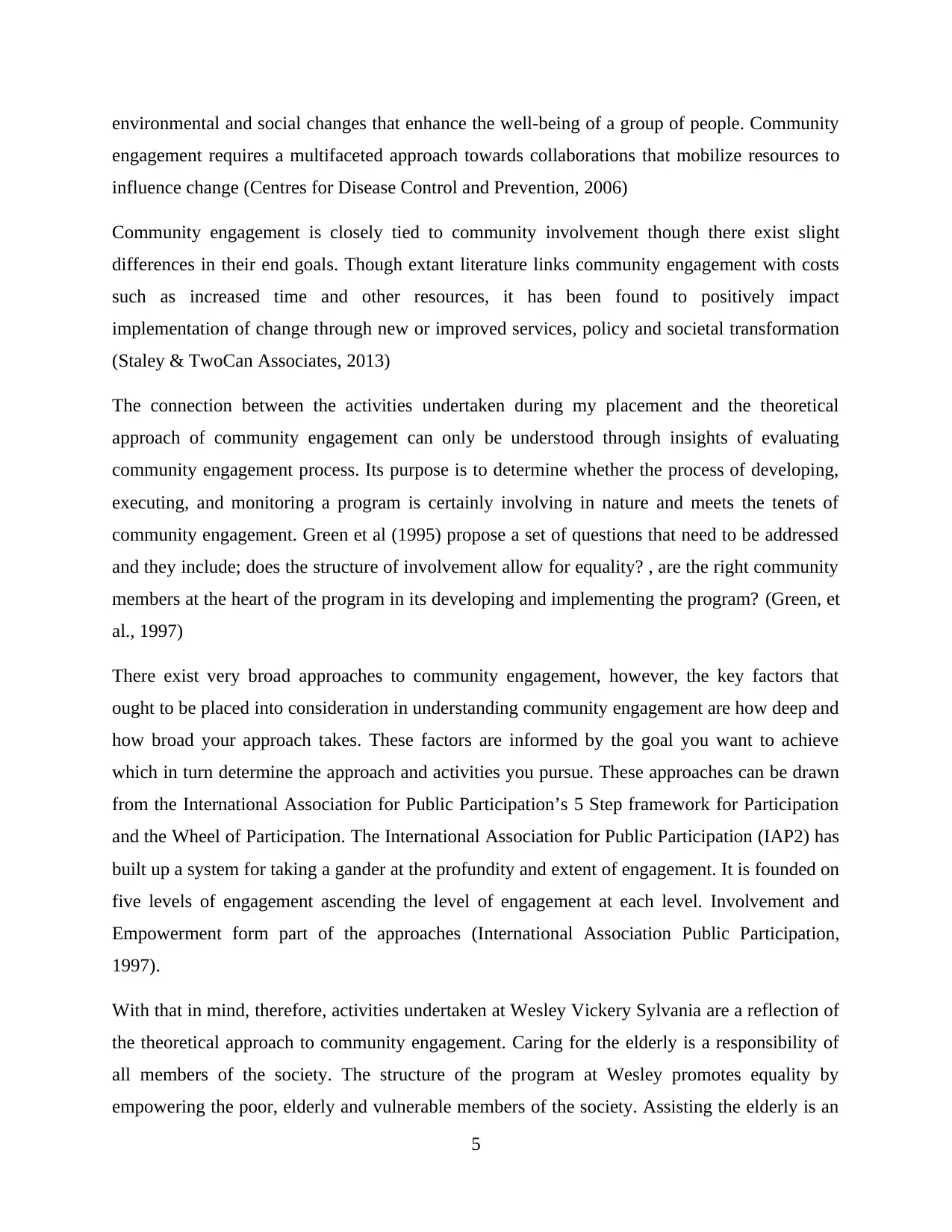
environmental and social changes that enhance the well-being of a group of people. Community
engagement requires a multifaceted approach towards collaborations that mobilize resources to
influence change (Centres for Disease Control and Prevention, 2006)
Community engagement is closely tied to community involvement though there exist slight
differences in their end goals. Though extant literature links community engagement with costs
such as increased time and other resources, it has been found to positively impact
implementation of change through new or improved services, policy and societal transformation
(Staley & TwoCan Associates, 2013)
The connection between the activities undertaken during my placement and the theoretical
approach of community engagement can only be understood through insights of evaluating
community engagement process. Its purpose is to determine whether the process of developing,
executing, and monitoring a program is certainly involving in nature and meets the tenets of
community engagement. Green et al (1995) propose a set of questions that need to be addressed
and they include; does the structure of involvement allow for equality? , are the right community
members at the heart of the program in its developing and implementing the program? (Green, et
al., 1997)
There exist very broad approaches to community engagement, however, the key factors that
ought to be placed into consideration in understanding community engagement are how deep and
how broad your approach takes. These factors are informed by the goal you want to achieve
which in turn determine the approach and activities you pursue. These approaches can be drawn
from the International Association for Public Participation’s 5 Step framework for Participation
and the Wheel of Participation. The International Association for Public Participation (IAP2) has
built up a system for taking a gander at the profundity and extent of engagement. It is founded on
five levels of engagement ascending the level of engagement at each level. Involvement and
Empowerment form part of the approaches (International Association Public Participation,
1997).
With that in mind, therefore, activities undertaken at Wesley Vickery Sylvania are a reflection of
the theoretical approach to community engagement. Caring for the elderly is a responsibility of
all members of the society. The structure of the program at Wesley promotes equality by
empowering the poor, elderly and vulnerable members of the society. Assisting the elderly is an
5
engagement requires a multifaceted approach towards collaborations that mobilize resources to
influence change (Centres for Disease Control and Prevention, 2006)
Community engagement is closely tied to community involvement though there exist slight
differences in their end goals. Though extant literature links community engagement with costs
such as increased time and other resources, it has been found to positively impact
implementation of change through new or improved services, policy and societal transformation
(Staley & TwoCan Associates, 2013)
The connection between the activities undertaken during my placement and the theoretical
approach of community engagement can only be understood through insights of evaluating
community engagement process. Its purpose is to determine whether the process of developing,
executing, and monitoring a program is certainly involving in nature and meets the tenets of
community engagement. Green et al (1995) propose a set of questions that need to be addressed
and they include; does the structure of involvement allow for equality? , are the right community
members at the heart of the program in its developing and implementing the program? (Green, et
al., 1997)
There exist very broad approaches to community engagement, however, the key factors that
ought to be placed into consideration in understanding community engagement are how deep and
how broad your approach takes. These factors are informed by the goal you want to achieve
which in turn determine the approach and activities you pursue. These approaches can be drawn
from the International Association for Public Participation’s 5 Step framework for Participation
and the Wheel of Participation. The International Association for Public Participation (IAP2) has
built up a system for taking a gander at the profundity and extent of engagement. It is founded on
five levels of engagement ascending the level of engagement at each level. Involvement and
Empowerment form part of the approaches (International Association Public Participation,
1997).
With that in mind, therefore, activities undertaken at Wesley Vickery Sylvania are a reflection of
the theoretical approach to community engagement. Caring for the elderly is a responsibility of
all members of the society. The structure of the program at Wesley promotes equality by
empowering the poor, elderly and vulnerable members of the society. Assisting the elderly is an
5
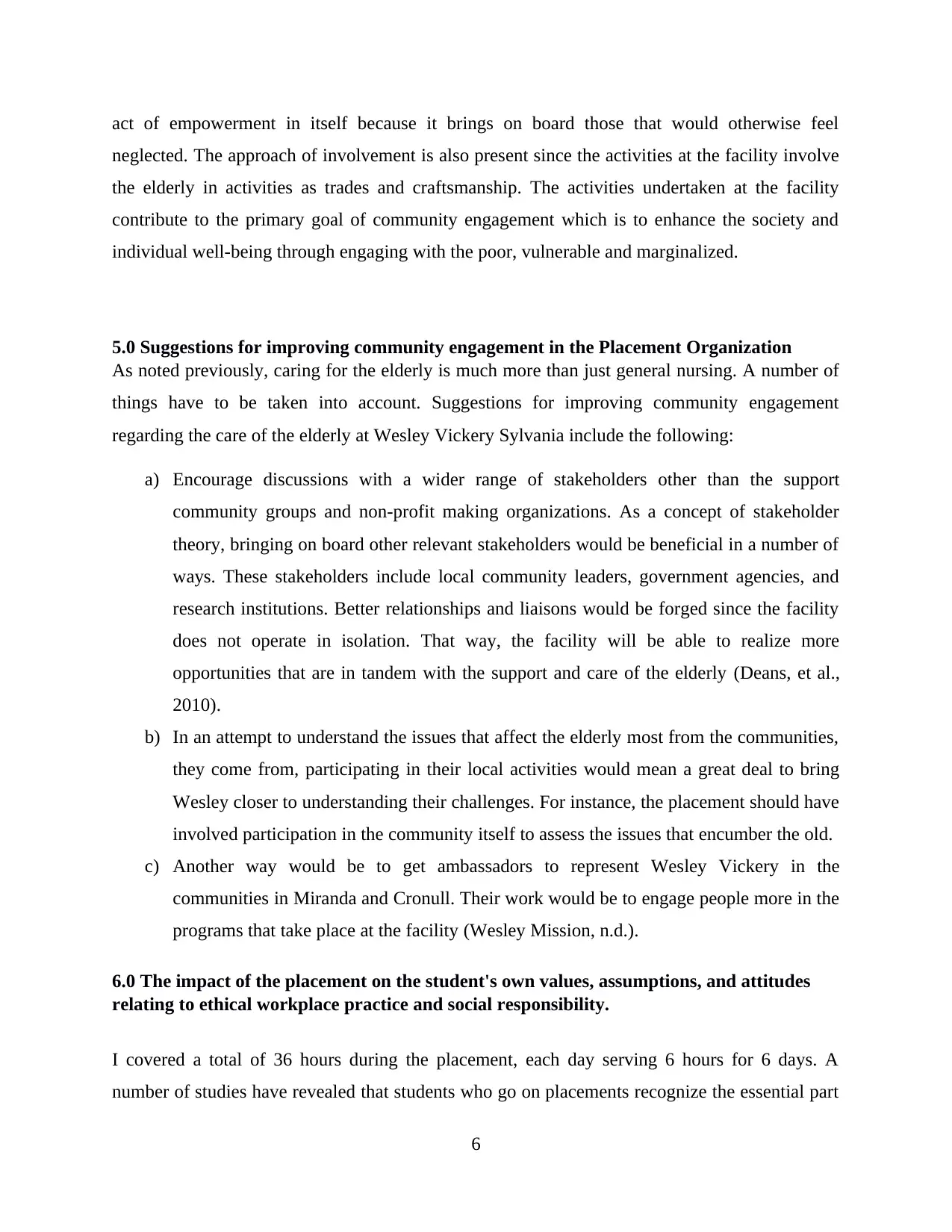
act of empowerment in itself because it brings on board those that would otherwise feel
neglected. The approach of involvement is also present since the activities at the facility involve
the elderly in activities as trades and craftsmanship. The activities undertaken at the facility
contribute to the primary goal of community engagement which is to enhance the society and
individual well-being through engaging with the poor, vulnerable and marginalized.
5.0 Suggestions for improving community engagement in the Placement Organization
As noted previously, caring for the elderly is much more than just general nursing. A number of
things have to be taken into account. Suggestions for improving community engagement
regarding the care of the elderly at Wesley Vickery Sylvania include the following:
a) Encourage discussions with a wider range of stakeholders other than the support
community groups and non-profit making organizations. As a concept of stakeholder
theory, bringing on board other relevant stakeholders would be beneficial in a number of
ways. These stakeholders include local community leaders, government agencies, and
research institutions. Better relationships and liaisons would be forged since the facility
does not operate in isolation. That way, the facility will be able to realize more
opportunities that are in tandem with the support and care of the elderly (Deans, et al.,
2010).
b) In an attempt to understand the issues that affect the elderly most from the communities,
they come from, participating in their local activities would mean a great deal to bring
Wesley closer to understanding their challenges. For instance, the placement should have
involved participation in the community itself to assess the issues that encumber the old.
c) Another way would be to get ambassadors to represent Wesley Vickery in the
communities in Miranda and Cronull. Their work would be to engage people more in the
programs that take place at the facility (Wesley Mission, n.d.).
6.0 The impact of the placement on the student's own values, assumptions, and attitudes
relating to ethical workplace practice and social responsibility.
I covered a total of 36 hours during the placement, each day serving 6 hours for 6 days. A
number of studies have revealed that students who go on placements recognize the essential part
6
neglected. The approach of involvement is also present since the activities at the facility involve
the elderly in activities as trades and craftsmanship. The activities undertaken at the facility
contribute to the primary goal of community engagement which is to enhance the society and
individual well-being through engaging with the poor, vulnerable and marginalized.
5.0 Suggestions for improving community engagement in the Placement Organization
As noted previously, caring for the elderly is much more than just general nursing. A number of
things have to be taken into account. Suggestions for improving community engagement
regarding the care of the elderly at Wesley Vickery Sylvania include the following:
a) Encourage discussions with a wider range of stakeholders other than the support
community groups and non-profit making organizations. As a concept of stakeholder
theory, bringing on board other relevant stakeholders would be beneficial in a number of
ways. These stakeholders include local community leaders, government agencies, and
research institutions. Better relationships and liaisons would be forged since the facility
does not operate in isolation. That way, the facility will be able to realize more
opportunities that are in tandem with the support and care of the elderly (Deans, et al.,
2010).
b) In an attempt to understand the issues that affect the elderly most from the communities,
they come from, participating in their local activities would mean a great deal to bring
Wesley closer to understanding their challenges. For instance, the placement should have
involved participation in the community itself to assess the issues that encumber the old.
c) Another way would be to get ambassadors to represent Wesley Vickery in the
communities in Miranda and Cronull. Their work would be to engage people more in the
programs that take place at the facility (Wesley Mission, n.d.).
6.0 The impact of the placement on the student's own values, assumptions, and attitudes
relating to ethical workplace practice and social responsibility.
I covered a total of 36 hours during the placement, each day serving 6 hours for 6 days. A
number of studies have revealed that students who go on placements recognize the essential part
6
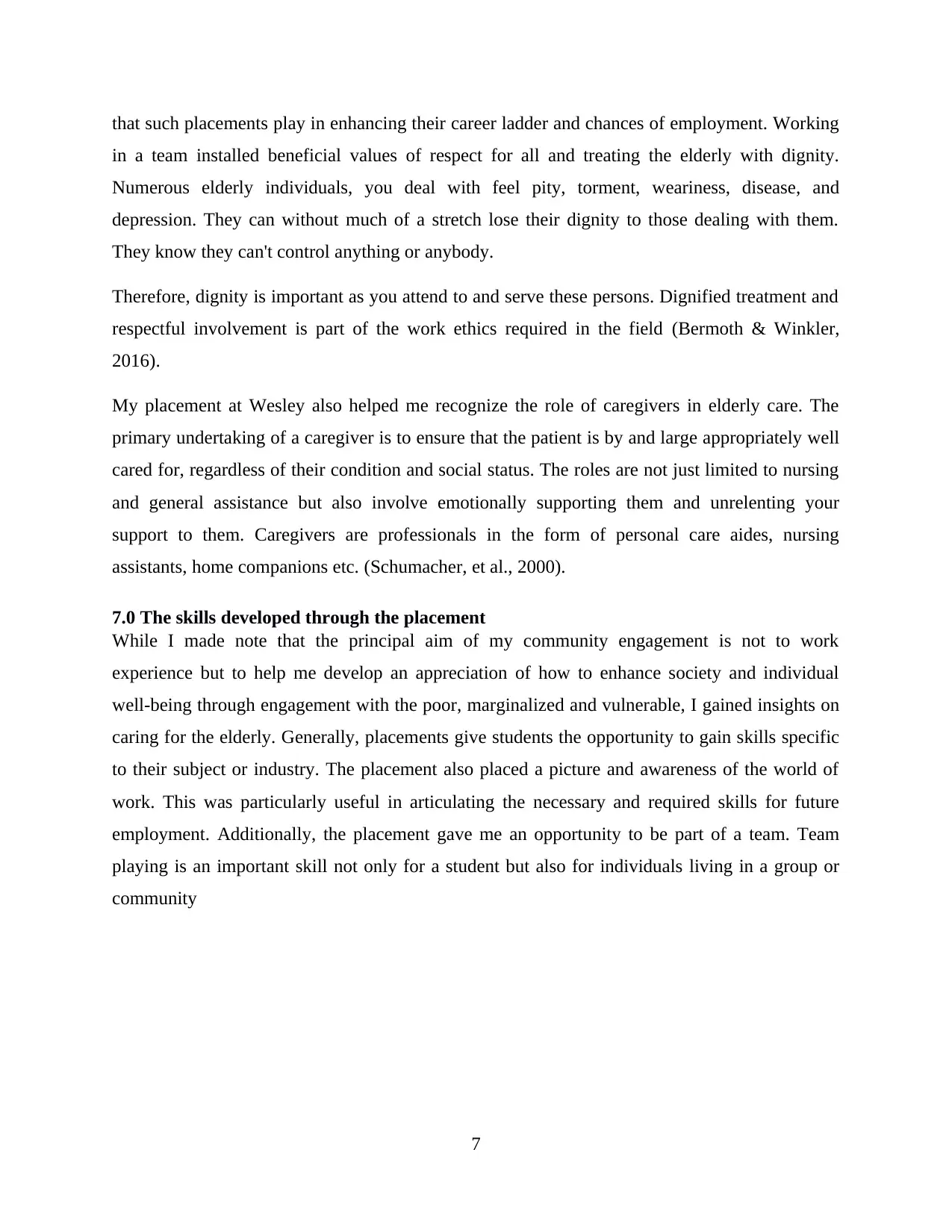
that such placements play in enhancing their career ladder and chances of employment. Working
in a team installed beneficial values of respect for all and treating the elderly with dignity.
Numerous elderly individuals, you deal with feel pity, torment, weariness, disease, and
depression. They can without much of a stretch lose their dignity to those dealing with them.
They know they can't control anything or anybody.
Therefore, dignity is important as you attend to and serve these persons. Dignified treatment and
respectful involvement is part of the work ethics required in the field (Bermoth & Winkler,
2016).
My placement at Wesley also helped me recognize the role of caregivers in elderly care. The
primary undertaking of a caregiver is to ensure that the patient is by and large appropriately well
cared for, regardless of their condition and social status. The roles are not just limited to nursing
and general assistance but also involve emotionally supporting them and unrelenting your
support to them. Caregivers are professionals in the form of personal care aides, nursing
assistants, home companions etc. (Schumacher, et al., 2000).
7.0 The skills developed through the placement
While I made note that the principal aim of my community engagement is not to work
experience but to help me develop an appreciation of how to enhance society and individual
well-being through engagement with the poor, marginalized and vulnerable, I gained insights on
caring for the elderly. Generally, placements give students the opportunity to gain skills specific
to their subject or industry. The placement also placed a picture and awareness of the world of
work. This was particularly useful in articulating the necessary and required skills for future
employment. Additionally, the placement gave me an opportunity to be part of a team. Team
playing is an important skill not only for a student but also for individuals living in a group or
community
7
in a team installed beneficial values of respect for all and treating the elderly with dignity.
Numerous elderly individuals, you deal with feel pity, torment, weariness, disease, and
depression. They can without much of a stretch lose their dignity to those dealing with them.
They know they can't control anything or anybody.
Therefore, dignity is important as you attend to and serve these persons. Dignified treatment and
respectful involvement is part of the work ethics required in the field (Bermoth & Winkler,
2016).
My placement at Wesley also helped me recognize the role of caregivers in elderly care. The
primary undertaking of a caregiver is to ensure that the patient is by and large appropriately well
cared for, regardless of their condition and social status. The roles are not just limited to nursing
and general assistance but also involve emotionally supporting them and unrelenting your
support to them. Caregivers are professionals in the form of personal care aides, nursing
assistants, home companions etc. (Schumacher, et al., 2000).
7.0 The skills developed through the placement
While I made note that the principal aim of my community engagement is not to work
experience but to help me develop an appreciation of how to enhance society and individual
well-being through engagement with the poor, marginalized and vulnerable, I gained insights on
caring for the elderly. Generally, placements give students the opportunity to gain skills specific
to their subject or industry. The placement also placed a picture and awareness of the world of
work. This was particularly useful in articulating the necessary and required skills for future
employment. Additionally, the placement gave me an opportunity to be part of a team. Team
playing is an important skill not only for a student but also for individuals living in a group or
community
7
Paraphrase This Document
Need a fresh take? Get an instant paraphrase of this document with our AI Paraphraser
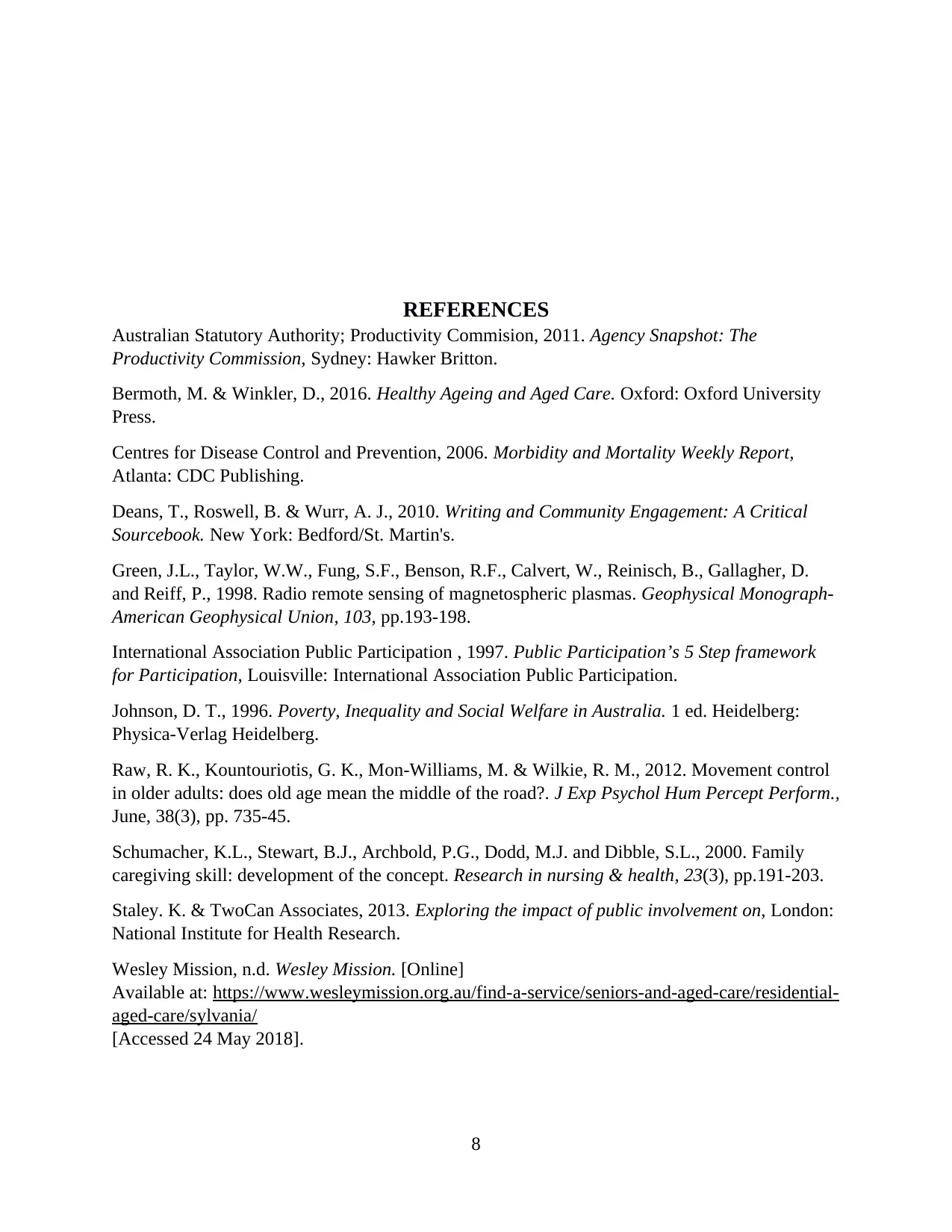
REFERENCES
Australian Statutory Authority; Productivity Commision, 2011. Agency Snapshot: The
Productivity Commission, Sydney: Hawker Britton.
Bermoth, M. & Winkler, D., 2016. Healthy Ageing and Aged Care. Oxford: Oxford University
Press.
Centres for Disease Control and Prevention, 2006. Morbidity and Mortality Weekly Report,
Atlanta: CDC Publishing.
Deans, T., Roswell, B. & Wurr, A. J., 2010. Writing and Community Engagement: A Critical
Sourcebook. New York: Bedford/St. Martin's.
Green, J.L., Taylor, W.W., Fung, S.F., Benson, R.F., Calvert, W., Reinisch, B., Gallagher, D.
and Reiff, P., 1998. Radio remote sensing of magnetospheric plasmas. Geophysical Monograph-
American Geophysical Union, 103, pp.193-198.
International Association Public Participation , 1997. Public Participation’s 5 Step framework
for Participation, Louisville: International Association Public Participation.
Johnson, D. T., 1996. Poverty, Inequality and Social Welfare in Australia. 1 ed. Heidelberg:
Physica-Verlag Heidelberg.
Raw, R. K., Kountouriotis, G. K., Mon-Williams, M. & Wilkie, R. M., 2012. Movement control
in older adults: does old age mean the middle of the road?. J Exp Psychol Hum Percept Perform.,
June, 38(3), pp. 735-45.
Schumacher, K.L., Stewart, B.J., Archbold, P.G., Dodd, M.J. and Dibble, S.L., 2000. Family
caregiving skill: development of the concept. Research in nursing & health, 23(3), pp.191-203.
Staley. K. & TwoCan Associates, 2013. Exploring the impact of public involvement on, London:
National Institute for Health Research.
Wesley Mission, n.d. Wesley Mission. [Online]
Available at: https://www.wesleymission.org.au/find-a-service/seniors-and-aged-care/residential-
aged-care/sylvania/
[Accessed 24 May 2018].
8
Australian Statutory Authority; Productivity Commision, 2011. Agency Snapshot: The
Productivity Commission, Sydney: Hawker Britton.
Bermoth, M. & Winkler, D., 2016. Healthy Ageing and Aged Care. Oxford: Oxford University
Press.
Centres for Disease Control and Prevention, 2006. Morbidity and Mortality Weekly Report,
Atlanta: CDC Publishing.
Deans, T., Roswell, B. & Wurr, A. J., 2010. Writing and Community Engagement: A Critical
Sourcebook. New York: Bedford/St. Martin's.
Green, J.L., Taylor, W.W., Fung, S.F., Benson, R.F., Calvert, W., Reinisch, B., Gallagher, D.
and Reiff, P., 1998. Radio remote sensing of magnetospheric plasmas. Geophysical Monograph-
American Geophysical Union, 103, pp.193-198.
International Association Public Participation , 1997. Public Participation’s 5 Step framework
for Participation, Louisville: International Association Public Participation.
Johnson, D. T., 1996. Poverty, Inequality and Social Welfare in Australia. 1 ed. Heidelberg:
Physica-Verlag Heidelberg.
Raw, R. K., Kountouriotis, G. K., Mon-Williams, M. & Wilkie, R. M., 2012. Movement control
in older adults: does old age mean the middle of the road?. J Exp Psychol Hum Percept Perform.,
June, 38(3), pp. 735-45.
Schumacher, K.L., Stewart, B.J., Archbold, P.G., Dodd, M.J. and Dibble, S.L., 2000. Family
caregiving skill: development of the concept. Research in nursing & health, 23(3), pp.191-203.
Staley. K. & TwoCan Associates, 2013. Exploring the impact of public involvement on, London:
National Institute for Health Research.
Wesley Mission, n.d. Wesley Mission. [Online]
Available at: https://www.wesleymission.org.au/find-a-service/seniors-and-aged-care/residential-
aged-care/sylvania/
[Accessed 24 May 2018].
8

9
1 out of 9
Your All-in-One AI-Powered Toolkit for Academic Success.
+13062052269
info@desklib.com
Available 24*7 on WhatsApp / Email
![[object Object]](/_next/static/media/star-bottom.7253800d.svg)
Unlock your academic potential
© 2024 | Zucol Services PVT LTD | All rights reserved.


